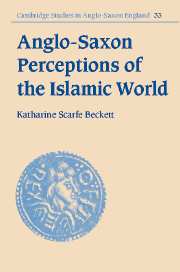Book contents
- Frontmatter
- Contents
- Acknowledgements
- List of abbreviations
- 1 Introduction
- 2 Islam during the Anglo-Saxon period
- 3 Anglo-Saxon contacts with Islam
- 4 Arabs and Arabia in Latin
- 5 Ismaelites and Saracens in Latin
- 6 Arabs, Ismaelites and Saracens in early Anglo-Latin
- 7 Pseudo-Methodius and the sons of Ismael
- 8 Arabs, Ismaelites and Saracens in Old English
- 9 Persisting theories about Saracens in post-Conquest England
- 10 Conclusions
- Bibliography
- Index
3 - Anglo-Saxon contacts with Islam
Published online by Cambridge University Press: 22 September 2009
- Frontmatter
- Contents
- Acknowledgements
- List of abbreviations
- 1 Introduction
- 2 Islam during the Anglo-Saxon period
- 3 Anglo-Saxon contacts with Islam
- 4 Arabs and Arabia in Latin
- 5 Ismaelites and Saracens in Latin
- 6 Arabs, Ismaelites and Saracens in early Anglo-Latin
- 7 Pseudo-Methodius and the sons of Ismael
- 8 Arabs, Ismaelites and Saracens in Old English
- 9 Persisting theories about Saracens in post-Conquest England
- 10 Conclusions
- Bibliography
- Index
Summary
Bede (c. 673–735) leaves no record that he knew of the Anglo-Saxon pilgrim Willibald (c. 700–87), an engaging character who spent several years in Muslim lands and smuggled balsam through customs in Tyre in a false-bottomed flask of petroleum. Although the two men were contemporaries, Willibald did not return to England after his travels through the Holy Land in AD 723–727, but became bishop of Eichstätt in what is now southern Germany. There, a nun of Anglo-Saxon origin called Hygeburg who had moved to Heidenheim composed the story of his life and travels known as the Vita Willibaldi. The uita was not written down until after Bede's death and seems never to have been known in England. This text will be considered in more detail below.
Bede did know of a Gaul called Arculf who had made the pilgrimage to Jerusalem during the period AD 679–682 and was shipwrecked on the west coast of England on his return. After travelling overland for a time Arculf encountered Adomnán, bishop of Iona, who recorded his account of the holy places. Adomnán was evidently concerned to present a plausible account; he stressed that Arculf was a reliable authority who saw the holy sights with his own eyes. He also occasionally noted that Arculf's account agreed with descriptions by earlier authorities, and mentioned some who had written on the same subjects.
- Type
- Chapter
- Information
- Anglo-Saxon Perceptions of the Islamic World , pp. 44 - 68Publisher: Cambridge University PressPrint publication year: 2003

